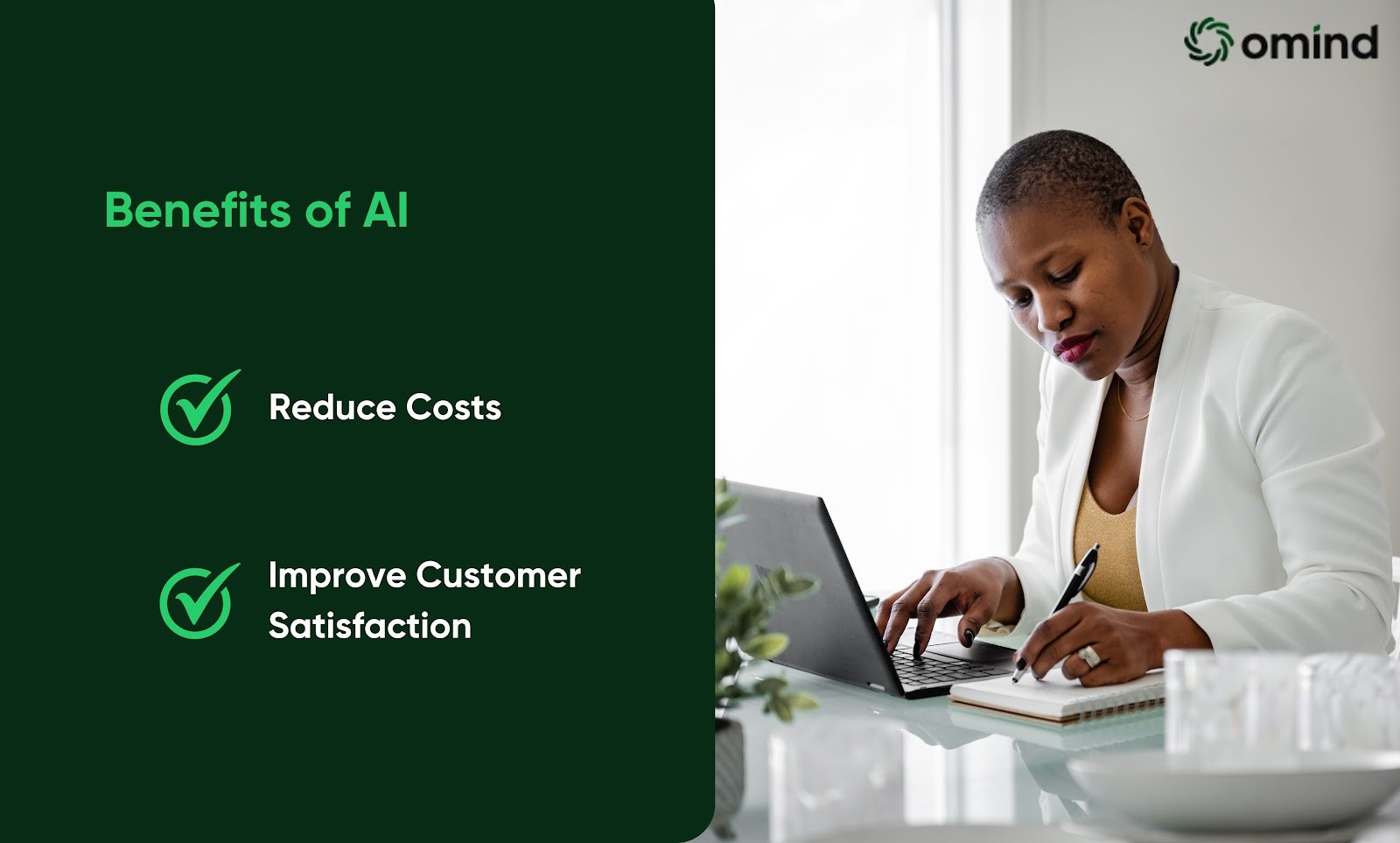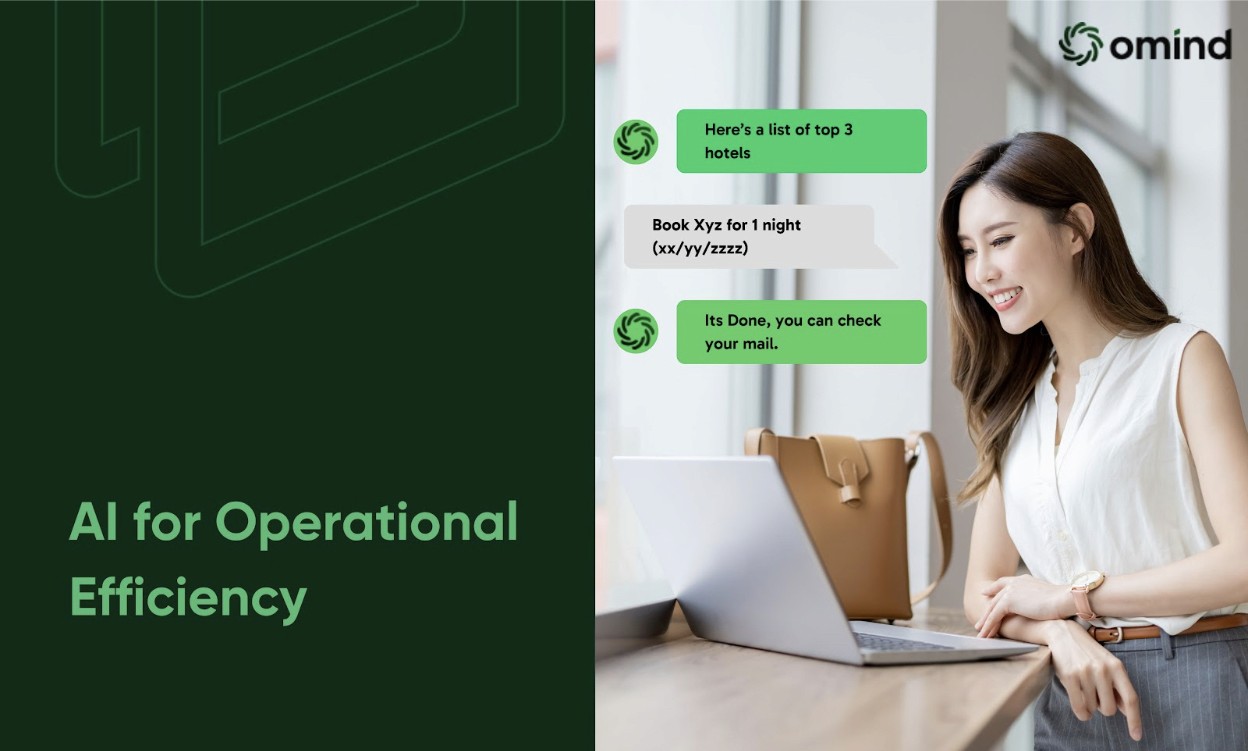AI (artificial intelligence) is emerging as a significant factor in propelling business growth. The AI operational efficiency is greater than ever as it is a smart assistant, especially for daily tedious tasks. With the help of this cutting-edge technology, companies can streamline their operations, saving time and resources. Whether improving customer experiences (CX), optimizing supply chains, or enhancing decision-making, AI helps firms maintain a competitive edge.
In this discussion, we'll explore the core use cases and strategies that AI can use to boost operational efficiency across various industries.
More About AI Operational Efficiency
The power of AI in operations can optimize business processes and increase efficiency. It consists of using the power of data and algorithms to identify patterns, use predictions, and automate tasks. Using this technology makes your business smarter and simpler.
The main advantage of artificial intelligence is productivity improvement. It is like having a pair of hands (or hundreds of them) to help you get things done. AI can automate repetitive tasks, analyze data lightning-fast, and even predict future needs. So, your team can prioritize what is important. Omind leverages AI technology to enhance productivity, making your operations more efficient.
Benefits of AI

Let's see how implementing this technology can help your business.
Reduce Costs: AI is one way to save money by streamlining processes and optimizing operations. Companies may reduce unnecessary expenses as they can automate many repeated tasks. For example, the human touch is necessary for all, but with AI implementation, you can save bills and labor costs without sacrificing quality.
Improve Customer Satisfaction: Making customers happy is unavoidable as it affects your business. Your clients are the ultimate users of your product, so using Artificial Intelligence can help you understand your customers better than ever before. By analyzing customer data, businesses can identify customers' needs and preferences and deliver personalized experiences.
Now that we've covered customer satisfaction let's explore some specific examples of how AI transforms operational efficiency across different sectors.
Core Use Cases of AI for Operational Efficiency
The revolution in AI is transforming businesses, and operational efficiency is at the forefront of this innovation. From manufacturing plants to call centres, this technology is helping every field to drive growth.
Software Development

The arrival of AI greatly benefited the software development area, boosting efficiency and productivity at every stage.
AI-powered Code Completion: Think of a situation where you get an automation option that suggests the following lines of code as you type. AI-powered code will do that, accelerating development speed, enhancing code quality, and reducing the burden on developers. This technology can learn from vast code repositories and provide intelligent suggestions, helping developers write cleaner and more efficient code. Using AI-driven tools is a great way to improve overall developer productivity and satisfaction.
Automated Code Review: Someone should have done the code review in the old methods, but now you can say goodbye to those methods. AI can automatically scan code, ensuring consistency, identifying bugs early, and freeing your staff for other essential tasks. By analyzing code against predefined coding standards and best practices, AI can often catch common errors and vulnerabilities, potentially reducing the risk of defects reaching production. An efficient system like this improves code quality and accelerates the development cycle.
Intelligent Bug Detection: The manual process of debugging is a time-consuming nightmare. Arriving the AI mitigated this risk, and now you can analyze code to pinpoint potential issues, reducing debugging time and improving code quality. By using advanced algorithms and machine learning, this innovation can identify patterns in code that indicate potential bugs, helping developers address issues more efficiently than ever.
You have seen how AI helps in the software development process. In the next section, we will see how HR will benefit from it.
Human Resources (HR)
AI operational efficiency is extended to various other areas. HR is also one of the areas where you can use this technology, such as recruitment, training, and more. Let's see some of the important areas.
Resume Screening: When you are hiring, you get plenty of qualified applications. By using AI, businesses can filter the most fitted top 10 candidates in less time. AI-powered resume screening quickly analyzes resumes, identifies top candidates based on job requirements, and prioritizes the most promising applicants. This automation saves HR valuable time and spends their time on building relationships. Use Omind's capabilities to screen resumes and select candidates efficiently with AI.
Predictive Hiring: With AI and data, a company can see which job candidates are most likely to do well in a given position. So, with this option, HR teams make more informed decisions and reduce turnover rates. These data-driven decisions and approaches can improve the overall quality of hires and strengthen the organization's talent pool.
Candidate Engagement Chatbots: Now, people are not ready to wait long for responses. The arrival of AI is an advantage, and organizations can automate candidate inquiries, schedule interviews, and keep applicants informed throughout the hiring process. This improves the candidate experience, reduces HR workload, and helps build a positive hiring experience.
Automated Interview Scheduling: Coordinating schedules for multiple interviewers and candidates will be risky for humans. With AI-powered tools, you can automate the process and suggest optimal times for interviews based on everyone's availability. Now, everyone can save time, reduce conflicts, and ensure a smoother interview process for candidates and interviewers.
Regarding risk management, let's examine how AI enhances operational processes in this sector.
Operations
The AI revolution has significantly benefited many companies' operational aspects. It automates tasks, optimizes processes, and provides valuable insights.
Automated Workflows: Imagine where a business can automatically handle daily jobs, freeing employees to focus on strategic thinking and problem-solving. With AI-powered automation, it's possible to streamline repetitive processes, reduce errors, and improve efficiency. By avoiding manual tasks, businesses can achieve faster turnaround times, enhance customer satisfaction, and create a quicker work environment.
Predictive Maintenance: AI is transforming how organizations maintain their equipment. With sensor data and identifying patterns, AI can predict when equipment will fail, which is essential when starting maintenance. This option helps prevent unexpected breakdowns, optimize resource allocation, and extend the lifespan of assets. Predictive maintenance helps identify potential hazards before they occur, creating a safer working environment for employees.
Finance

Finance is one of the other important sections in which AI is revolutionizing, such as improving accuracy, efficiency, and risk management.
Invoice Processing: Manual invoice processing is time-consuming, and sometimes, you may make errors. AI-powered automation can streamline this process through technologies such as Optical Character Recognition (OCR) for data extraction, intelligent classification for sorting invoices, smart matching for comparing invoices with purchase orders, and exception handling for complex cases. It is essential to reduce processing time and minimize the chances of risk with error.
Fraud Detection and Risk Management: Financial institutions may face constant fraud threats, and AI can mitigate this risk and protect assets by monitoring real-time transactions, identifying suspicious patterns, and generating automated alerts. Predictive analytics, including those provided by companies like Omind, can help forecast potential fraud risks and protect your business.
In the following sections, lets see the strategies for implementing AI operational efficiency.
Strategies for Implementing AI in Operational Processes
Using the power of AI will benefit a lot, but integrating it into your operations requires a perfect plan. Here are key steps to guide you:
Objectives and Goals: Before selecting an AI, clearly outline what you want to achieve with this technology. This can be anything like boosting efficiency, enhancing decision-making, or improving customer satisfaction. Having clear goals will keep your AI project focused and connect with your overall business objectives. You can also consider involving key stakeholders in the goal-setting process for buy-in and support.
Understand Business Processes: The second process is to understand your current processes so that you can identify areas for automation or optimization. When you know exactly where you want to use AI operational efficiency, you select the right AI applications and measure their impact effectively. Moreover, documenting your business processes can provide valuable insights into potential problems and inefficiencies.
Ensure Data Quality: High-quality data is the advantage of successful AI implementation. Invest time and resources in cleaning, organizing, and structuring your data. This includes identifying and addressing missing data, inconsistencies, and biases so that you can make better decisions.
Choose AI Technology: Select the AI that best suits your specific needs and goals. Consider factors like the complexity of the problem, data availability, and your team's expertise. Also, remember to evaluate the technology's scalability and flexibility to accommodate future growth.
Improvements with Feedback: Implementing AI technology is the first step, but a business collecting feedback and refining its AI models is not accessible. If you want your AI solutions to stay relevant and practical as your business evolves, you should follow this method. Establish a feedback loop with end-users to gather insights into the AI system's performance and identify areas for improvement.
Scalability and Integration: Given the ever-evolving market conditions, find an AI solution to handle increased workloads and integrate easily with your existing systems. Scalability allows you to expand your AI initiatives, while integration prevents data silos and improves efficiency. Also, think about how AI might affect your IT system and make plans based on that. Omind's scalable and flexible AI solutions are designed to grow with your business needs.
Monitor and Evaluate Performance: Track the performance of your AI implementations by using key metrics to measure ROI, identify improvement areas, and demonstrate AI's value to stakeholders. Regular performance evaluations are essential to identify emerging trends and opportunities for AI expansion.
Great. Now that you know how to monitor and evaluate, let's examine the future trends of AI for operational efficiency.
Future Trends in AI for Operational Efficiency
The future of AI offers many opportunities to transform operational efficiency. Let's examine some of the trends now.
AI is becoming more complex, so understanding how it makes its decisions becomes essential. Explainable AI intends to open up the "black box" of AI models by giving clear, comprehensible reasons for what they do. This openness builds trust, helps people make decisions, and ensures rules are followed.
Businesses are now looking to reduce their environmental impact. AI can play a vital role in creating more sustainable operations by optimizing energy consumption, minimizing waste, and improving supply chain efficiency. By leveraging AI, organizations may identify opportunities to reduce their carbon footprint and contribute to more sustainable practices.
The world is moving forward, and AI operational efficiency must keep up with the pace. Continuous improvement is essential for maximizing the value of AI investments. AI models should be regularly updated with new data, refined algorithms, and advanced techniques like reinforcement learning explored to achieve ongoing performance improvement.
Considering those future trends, let's wrap this up by considering how Omind can be your AI-powered efficiency engine.
Choose Omind AI-Powered Efficiency Engine
AI is useful at all levels in many ways. It reshapes operations by automating tasks, optimizing processes, and delivering valuable insights. A business can improve efficiency, reduce costs, and drive growth. Continuously monitor the performance to unlock the full potential of AI and gain a competitive edge.
Imagine you get a provider for business as a high-performance machine. Omind is the AI-fueled engine that propels it forward and improves your efficiency. They help you with everything from customer experiences to operational workflows, delivering maximum performance and exceptional results. Partner with Omind and improve your productivity ai operational efficiency. Contact us today to schedule a demo.
AUTHOR
Team Omind
Empowering Businesses with Unified Customer Experience Platform, Leveraging Advanced AI and Intelligent Automation
PRODUCT
QMS
Share LINK
Related Blogs




